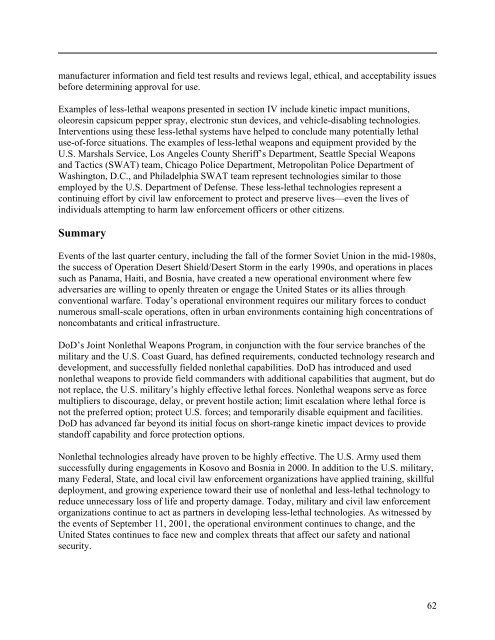Department of Defense Nonlethal Weapons and Equipment Review
Department of Defense Nonlethal Weapons and Equipment Review
Department of Defense Nonlethal Weapons and Equipment Review
You also want an ePaper? Increase the reach of your titles
YUMPU automatically turns print PDFs into web optimized ePapers that Google loves.
manufacturer information <strong>and</strong> field test results <strong>and</strong> reviews legal, ethical, <strong>and</strong> acceptability issues<br />
before determining approval for use.<br />
Examples <strong>of</strong> less-lethal weapons presented in section IV include kinetic impact munitions,<br />
oleoresin capsicum pepper spray, electronic stun devices, <strong>and</strong> vehicle-disabling technologies.<br />
Interventions using these less-lethal systems have helped to conclude many potentially lethal<br />
use-<strong>of</strong>-force situations. The examples <strong>of</strong> less-lethal weapons <strong>and</strong> equipment provided by the<br />
U.S. Marshals Service, Los Angeles County Sheriff’s <strong>Department</strong>, Seattle Special <strong>Weapons</strong><br />
<strong>and</strong> Tactics (SWAT) team, Chicago Police <strong>Department</strong>, Metropolitan Police <strong>Department</strong> <strong>of</strong><br />
Washington, D.C., <strong>and</strong> Philadelphia SWAT team represent technologies similar to those<br />
employed by the U.S. <strong>Department</strong> <strong>of</strong> <strong>Defense</strong>. These less-lethal technologies represent a<br />
continuing effort by civil law enforcement to protect <strong>and</strong> preserve lives—even the lives <strong>of</strong><br />
individuals attempting to harm law enforcement <strong>of</strong>ficers or other citizens.<br />
Summary<br />
Events <strong>of</strong> the last quarter century, including the fall <strong>of</strong> the former Soviet Union in the mid-1980s,<br />
the success <strong>of</strong> Operation Desert Shield/Desert Storm in the early 1990s, <strong>and</strong> operations in places<br />
such as Panama, Haiti, <strong>and</strong> Bosnia, have created a new operational environment where few<br />
adversaries are willing to openly threaten or engage the United States or its allies through<br />
conventional warfare. Today’s operational environment requires our military forces to conduct<br />
numerous small-scale operations, <strong>of</strong>ten in urban environments containing high concentrations <strong>of</strong><br />
noncombatants <strong>and</strong> critical infrastructure.<br />
DoD’s Joint <strong>Nonlethal</strong> <strong>Weapons</strong> Program, in conjunction with the four service branches <strong>of</strong> the<br />
military <strong>and</strong> the U.S. Coast Guard, has defined requirements, conducted technology research <strong>and</strong><br />
development, <strong>and</strong> successfully fielded nonlethal capabilities. DoD has introduced <strong>and</strong> used<br />
nonlethal weapons to provide field comm<strong>and</strong>ers with additional capabilities that augment, but do<br />
not replace, the U.S. military’s highly effective lethal forces. <strong>Nonlethal</strong> weapons serve as force<br />
multipliers to discourage, delay, or prevent hostile action; limit escalation where lethal force is<br />
not the preferred option; protect U.S. forces; <strong>and</strong> temporarily disable equipment <strong>and</strong> facilities.<br />
DoD has advanced far beyond its initial focus on short-range kinetic impact devices to provide<br />
st<strong>and</strong><strong>of</strong>f capability <strong>and</strong> force protection options.<br />
<strong>Nonlethal</strong> technologies already have proven to be highly effective. The U.S. Army used them<br />
successfully during engagements in Kosovo <strong>and</strong> Bosnia in 2000. In addition to the U.S. military,<br />
many Federal, State, <strong>and</strong> local civil law enforcement organizations have applied training, skillful<br />
deployment, <strong>and</strong> growing experience toward their use <strong>of</strong> nonlethal <strong>and</strong> less-lethal technology to<br />
reduce unnecessary loss <strong>of</strong> life <strong>and</strong> property damage. Today, military <strong>and</strong> civil law enforcement<br />
organizations continue to act as partners in developing less-lethal technologies. As witnessed by<br />
the events <strong>of</strong> September 11, 2001, the operational environment continues to change, <strong>and</strong> the<br />
United States continues to face new <strong>and</strong> complex threats that affect our safety <strong>and</strong> national<br />
security.<br />
62

















